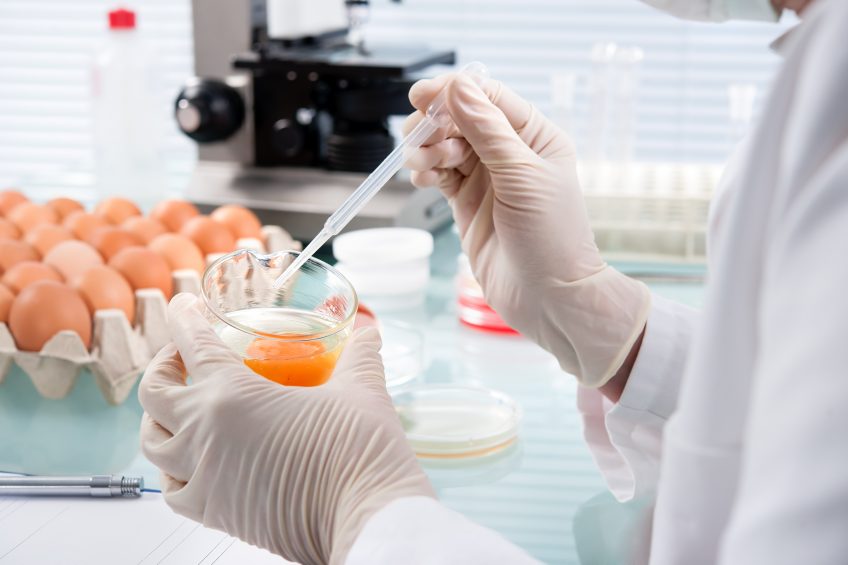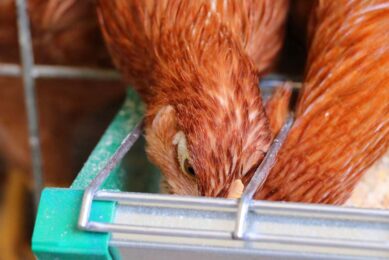Supporting egg quality through feed solutions

Egg quality is an important criterion for layer producers and has important economic implications. Poor quality can lead to downgrading, while enhanced quality can help improve the value of egg production. Egg quality is a concern for the whole industry, from shell resistance associated with farmers’ remuneration, to yolk colour, commonly misinterpreted as a sign of quality by consumers.
Egg quality is strongly related to hens’ nutrition and digestive function. In this context, it appears that certain natural feed additives, proven to enhance the animals’ digestion and antioxidant status, can help improve egg quality. These additives represent safe and natural tools to help producers enhance egg production.
Egg physical quality impacts farmer income
Egg quality is a multi-criteria parameter encompassing both physical and biochemical standards. In retail egg production, egg physical quality which refers to eggshell cleanliness, thickness, shape and integrity directly impacts farmer income through the downgrading rate. Dirty, soft, weak or cracked shells can be eliminated in the barn by the egg producer or during collecting, calibration and packing by the food industry. Field observations indicate that 5-15% of eggs can be downgraded.
Egg quality goes beyond the shell
Eggshell quality is a visible criterion, but you cannot judge a book by its cover! Albumen and yolk quality are also keys. Mainly constituted of lipoproteins, minerals and vitamins, yolk nutrients offer valuable ingredients to the food industry: liposoluble pigments (carotenoids) can, for example, be extracted for their colouring properties. In addition, yolk colour as well as egg lipids and cholesterol contents, are important to consumers.
Egg albumen quality
As for the albumen, its aspect and quality are associated with egg freshness. Storage times, high temperature, hens’ age or antioxidant status are all factors favouring the degradation of albumen protein, leading to liquefaction. In the industry, albumen height converted into Haugh Units, is used to assess egg freshness (see photo).
Packaging centres typically require Haugh Unit values above 60. Hence, egg quality management can help farmers leverage their production at a time when the focus should be on optimising, rather than maximising, animal production.
The impact of nutrition on egg quality
It has been established that nutrition can help optimise both egg production and egg mass, within the genetic potential of each strain. The feed energy level, protein content and ability to cover the hens’ daily requirements of amino acid or trace elements, are key criteria that nutritionists and technicians have increasingly learned to keep under control to optimise both laying performance and egg quality.
Eggshell formation is a complex mineralisation process that is among the most rapid in nature: it takes less than 20 hours to form 6 to 7 grammes shell!
In order to promote the integrity of the eggshell, conditions must be optimal to the arrangement of calcite crystals that compose the shell. First of all, nutrition must provide sufficient calcium levels, as early as the pullet stage, in order to ensure both bone and eggshell mineralisation. Calcium intake by the birds is then influenced by the size of the calcium carbonate particles. Finally, once it is consumed, calcium absorption in the gut should also be optimal. The latter is linked to the digestive process and can also be optimised thanks to improved digestive function. Natural feed supplements that are proven to optimise digestive functions, such as probiotics, are thus a tool to consider when facing eggshell formation issues. Probiotics are proven to help optimise the digestive process and the gut environment and can be used to help reduce pathogen pressure, as well as to help improve feed efficiency and production performance: more egg mass is produced per kg of feed. In addition, several trials indicate that a live lactic acid bacteria probiotic (see Probiotic for hens’ nutrition), thanks to its documented beneficial effects on digestibility, can also act on eggshell quality as well as several other quality parameters. Results show that probiotic bacteria supplementation at 100 g/T (equivalent to 106 CFU/g) of feed for a long period of time improves several eggshell quality parameters such as thickness or relative weight, finally reducing the % downgraded (Figure 1).
Figure 1 – Effect of BACTOCELL on the downgrade rate in different research trials (p<0.05).>

This is all the more important when considering that P. acidilactici MA 18/5M increases the egg weight by +2% on average (+1g/egg). Bigger eggs are commonly associated with more breakable shells. This positive effect on the downgraded rate is explained by research which analysed detailed criteria and measured a significant higher (p<0.001) eggshell thickness (0.331 mm vs. 0.306 mm) and eggshell relative weight (10.10% vs. 9.51%). the researchers also observed a significantly higher (p="0.008)" egg specific gravity (1.080 g.cm-3 vs. 1.076 g.cm-3). it is relevant to highlight that in this trial researchers also identified the downgrading causes: the number of 'broken eggs,' vs. egg-shell eggs, etc.>

The number of broken eggs has been divided by 2 and shell-less eggs have been reduced by two-thirds. Finally, authors measured 8% higher calcium retention in the supplemented group (p=0.064). Eggshell is made of around 38% calcium. It could be hypothesised that the probiotic, through its positive effect on the digestive process, increases calcium assimilation, which is translated into thicker, stronger eggshells.
Yolk quality is mainly related to yolk colour and cholesterol content. The yolk colour is monitored by the natural (corn, alfalfa, etc.) or synthetic pigments contained in feed. Xanthophylls are the main pigments responsible for yolk colour. Those liposoluble molecules are exclusively provided through the feed. Similar to what is observed with probiotic supplementation for calcium assimilation, it can also be hypothesised that an improved gut function enhancing the digestive process would have a positive impact on feed pigments utilisation during yolk formation.
Probiotic benefits for eggs
Indeed, it has been observed that probiotic benefits do not stop at the eggshell. Various research trials have shown that egg biochemical parameters can be improved too, following the lactic acid bacteria supplementation. Positive effects have been seen in enhanced yolk pigmentation, decreased meat spots in eggs and lower egg yolk cholesterol level (-22%, equivalent to -330 mg/100 g of yolk, as well as the hens’ serum cholesterol level); an interesting effect in terms of consumers’ health and acceptance.
The effects on cholesterol levels suggest an implication of lactic bacteria in lipid metabolism, but the actual modes of action are not fully elucidated. Larbier previously observed a significant increase (p<0.05) of lipid digestibility with p. acidilactici ma 18 5m in grower-finisher broilers . in 2012, mikulski>et al. noticed a linear increase (+2.5%, p<0.05) in ether extract digestibility coefficients in response to increased probiotic levels in laying hens’ feed. finally, mohan>et al. attributed the decrease of cholesterol to reduction of absorption and/or synthesis of cholesterol in the gastrointestinal tract. It is possible that probiotics could assimilate the cholesterol present in the gastrointestinal tract for their own cellular metabolism. Although it is primarily used by producers to balance hens’ gut microflora and improve laying performance, P. acidilactici confirms its beneficial effects in the digestive tract, offering additional egg quality benefits for the producer.
Enhancing egg freshness
As indicated earlier, the albumen Haugh Unit measurement is an indicator of egg freshness and storage possibility. Recent studies have shown that the supplementation of hens’ diets with a natural source of primary antioxidants (MELOFEED, which is a specific melon juice concentrate rich in antioxidant enzymes SOD and catalase), significantly improves egg Haugh Units. The standard for egg freshness (>60 Haugh Units) is prolonged by an additional week with the supplement (Figure 2): eggs produced by supplemented hens appear as fresh at 21 days of storage as those produced by control hens at 14 days of storage.
Figure 2 – Effect of MELOFEED® supplementation on egg Haugh Unit and
apparent freshness.

The same study also highlighted a 9% improvement of vitamin E transfer to the egg with the supplement, which is a sign of a hens’ enhanced antioxidant status. In addition, the supplementation of hens’ diet with selenium yeast (ALKOSEL R397) has been demonstrated to specifically increase the whole egg, albumen and yolk compartment Se concentration, which is also correlated to the animal’s antioxidant status.
All along the egg formation process, nutrition — and in particular natural additives such as probiotics and antioxidants — can help manage egg quality, from the yolk to the eggshell. In particular, the usage of documented probiotics shows egg quality benefits at different levels: eggshell resistance and calcium retention, yolk colour and cholesterol levels and meat spot reduction. Such benefits are in line with their benefits on laying performance and the translation of the proven modes of action of the probiotic on gut microflora balance, digestion and gut maturation.
Probiotic for hens’ nutrition
Probiotics are defined as “live micro-organisms which, when administered in adequate amounts, confer a health benefit on the host.” Pediococcus acidilactici MA 18/5M is a lactic bacteria strain specifically selected for its benefits in the digestive tract of monogastric animals. Its modes of action and efficacy have been well documented on lactic acid production, digestive microflora balance and gut maturity. These effects translate into recognised benefits on hens’ laying performance, as validated by its European registration as a zootechnical feed additive. In addition, due to its beneficial effects on digestion, several trials indicate that the probiotic bacteria can benefit the various parameters of egg quality.
Join 31,000+ subscribers
Subscribe to our newsletter to stay updated about all the need-to-know content in the poultry sector, three times a week. Beheer
Beheer








 WP Admin
WP Admin  Bewerk bericht
Bewerk bericht